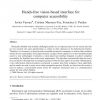Free Online Productivity Tools
i2Speak
i2Symbol
i2OCR
iTex2Img
iWeb2Print
iWeb2Shot
i2Type
iPdf2Split
iPdf2Merge
i2Bopomofo
i2Arabic
i2Style
i2Image
i2PDF
iLatex2Rtf
Sci2ools
JNCA
2008
2008
Hands-free vision-based interface for computer accessibility
Physically disabled and mentally challenged people are an important part of our society that has not yet received the same opportunities as others in their inclusion in the Information Society. Therefore, it is necessary to develop easily accessible systems for computers to achieve their inclusion within the new technologies. This paper presents a project whose objective is to draw disabled people nearer to new technologies. It presents a vision-based user interface designed to achieve computer accessibility for disabled users with motor impairments. The interface automatically finds the user's face and tracks it through time to recognize gestures within the face region in real time. Subsequently, a new information fusion procedure is proposed to acquire data from computer vision algorithms and its results are used to carry out a robust recognition process. Finally, we show how the system is used to replace a conventional mouse device for computer interaction and as a communicati...
| Added | 13 Dec 2010 |
| Updated | 13 Dec 2010 |
| Type | Journal |
| Year | 2008 |
| Where | JNCA |
| Authors | Javier Varona, Cristina Manresa-Yee, Francisco J. Perales López |
Comments (0)

